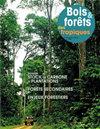Phytodiversité et services écosystémiques associés aux plantations d’alignement des rues aménagées de la ville de Grand-Popo au Bénin
IF 0.6
4区 农林科学
Q3 FORESTRY
引用次数: 3
Abstract
The importance of urban vegetation in generating ecosystem services in general has been widely demonstrated. In Benin, as well as the social and ecological benefits attributed to avenue trees, they also contribute significantly to the provision of supply and socio-cultural services via a range of uses by the population. This study assesses the contribution of plant biodiversity in city streets to the supply of goods and services to residents of Grand-Popo in Benin. The methodological approach used involved counting the number of trees planted along ten kilometres of managed roadways and conducting interviews with 164 households on the services provided by these trees. The diversity parameters were calculated to assess phytodiversity along these roadways. A table was complied to show the types of uses of tree organs in relation to existing ecosystem service categories. A total of 540 trees, belonging to 26 species and 17 families, were counted along the main streets of the city. Shannon's average biodiversity index (3.61 ± 0.14 bits) and the Pielou index of evenness (0,76 ± 0,06) show that some species are dominant, the most representative of these being Cocos nucifera with 20 % of total individuals. These avenue trees were mainly planted by the public authorities for shade, ornamental and carbon sequestration purposes. In practice, the uses made of these trees and the introduction of new species that are useful to the adjacent populations equate to the provision of more than nine ecosystem services, with shade and food rated as particularly important. To develop urban forestry, this kind of information would help to promote ecosystem services without compromising the viability of urban tree plantations.贝宁大波波市与街道对齐种植园相关的植物多样性和生态系统服务
一般来说,城市植被在产生生态系统服务方面的重要性已得到广泛证明。在贝宁,林荫道树木除了具有社会和生态效益外,还通过人口的一系列用途,为提供供应和社会文化服务作出了重大贡献。本研究评估了贝宁城市街道上的植物生物多样性对大波波居民商品和服务供应的贡献。所采用的方法包括计算沿10公里管理道路种植的树木数量,并就这些树木提供的服务与164户家庭进行面谈。通过计算多样性参数来评估这些道路沿线的植物多样性。编制了一份表格,显示树木器官的使用类型与现有生态系统服务类别的关系。在城市的主要街道上,共有540棵树,隶属于17科26个物种。Shannon的平均生物多样性指数(3.61±0.14 bits)和Pielou均匀度指数(0.76±0.06 bits)表明,部分物种具有优势,其中最具代表性的是Cocos nucifera,占总个体数的20%。这些行道树主要是由公共当局种植的,用于遮荫、观赏和碳封存目的。在实践中,对这些树木的利用和对邻近种群有用的新物种的引入相当于提供了九种以上的生态系统服务,其中遮阳和食物被认为是特别重要的。为了发展城市林业,这类信息将有助于促进生态系统服务,而不损害城市人工林的生存能力。
本文章由计算机程序翻译,如有差异,请以英文原文为准。
求助全文
约1分钟内获得全文
求助全文
来源期刊

Bois et Forets Des Tropiques
FORESTRY-
CiteScore
1.50
自引率
16.70%
发文量
31
审稿时长
>12 weeks
期刊介绍:
In 1947, the former Tropical Forest Technical Centre (CTFT), now part of CIRAD, created the journal Bois et Forêts des Tropiques. Since then, it has disseminated knowledge and research results on forests in intertropical and Mediterranean regions to more than sixty countries. The articles, peer evaluated and reviewed, are short, synthetic and accessible to researchers, engineers, technicians, students and decision-makers. They present original, innovative research results, inventions or discoveries. The journal publishes in an international dimension. The topics covered are of general interest and are aimed at an informed international audience.
 求助内容:
求助内容: 应助结果提醒方式:
应助结果提醒方式:


